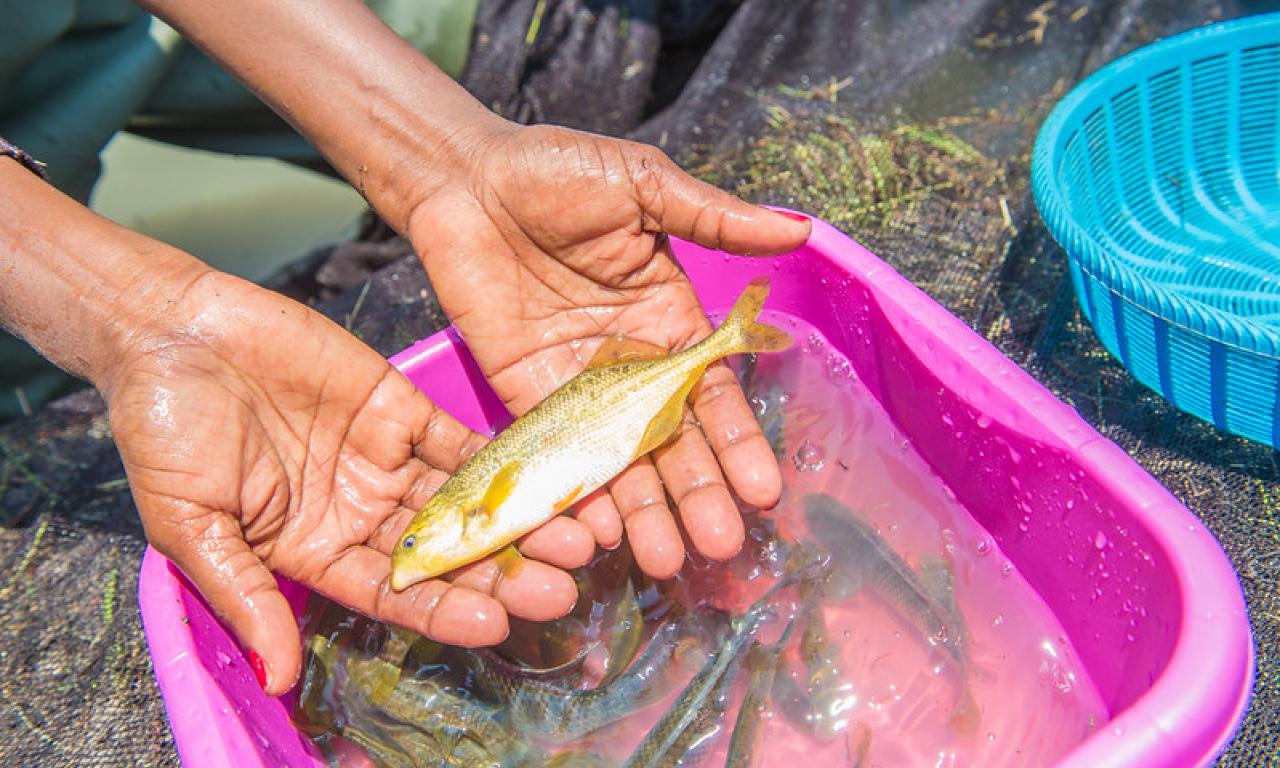
- Food, land, and water systems face daunting challenges in the future, and the body of research exploring these challenges is growing rapidly.
- This note is part of a series developed by the CGIAR Foresight Initiative to summarize what we know today about the future of various aspects of food systems.
- The goal of these notes is to serve as a quick reference, point to further information, and help guide future research and decisions.
Key messages
- Demand for aquatic foods has been increasing rapidly due to population growth, rising incomes, and increasing appreciation for the health benefits of fish consumption. The rapid growth of aquaculture in the past two decades has been the key contributor to meeting the increasing demand for aquatic foods.
- Aquatic foods are nutrient-rich, generate low emissions and impacts on land and water, and contribute to the human health, wellbeing, and livelihoods of rural communities.
- The latest fish foresight studies provide multifaceted insights into future scenarios of technological progress, climate change, population growth, diet transformation, urbanization, investments, and policy shifts in the fish sector and the potential for fish to provide nutrition-sensitive interventions for combating food insecurity and malnutrition at the global, regional, and national levels.
- Further foresight studies are needed to inform policymaking and develop a deeper understanding of the role aquatic foods can play in addressing the nutritional, social, and environmental food system challenges while navigating the trade-offs of pursuing these different goals.
Recent trends and challenges
Food, land, and water systems are facing unprecedented change. Nourishing 9.8 billion people with a healthy and sustainable diet by 2050 and within planetary boundaries is recognized as one of the biggest challenges facing humanity. Aquatic foods offer significant potential in the transformation of food systems toward healthy and sustainable diets, sustaining livelihoods, and generating income for women and youth, and are accessible to vulnerable populations even in the face of political shocks and market failures, such as those brought about by COVID-19. Yet, the role of aquatic foods has been largely overlooked and has remained remarkably absent from many contemporary food system discussions and policies.
Demand for aquatic foods has been increasing rapidly due to the population growth, rising incomes, and increasing appreciation for the health benefits of fish consumption. The rapid growth of aquaculture in the past two decades has been the key contributor to meeting the increasing demand for aquatic foods. Some aquaculture systems are associated with environmental drawbacks, highlighting the need for new approaches to sustainability. Also, expanding the production of food from the sea will bring co-benefits and trade-offs and will require national and inter-regional governance, as well as local capacity to ensure equity and sustainability.
The productivity, biodiversity, and carbon-sequestering functions of aquatic ecosystems are threatened by multiple factors, including pollution, the proliferation of disease outbreaks, climate change, competing water demands, lack of effective fisheries management to combat illegal, unreported and unregulated fishing, habitat degradation, and infrastructure development and land use change. Carefully managed aquatic food systems that include ‘nature-based solutions’ can deliver better impacts on “ecological, economic, and social needs, as well as increased employment and food security”.
What is the latest foresight research on aquatic food systems, and what do those studies show?
In recent years, aquatic foods have become more integrated into foresight models of the agriculture and land-use sectors. To date, fish commodities have been included in several partial-equilibrium economic models, including the International Model for Policy Analysis of Agriculture Commodities and Trade (IMPACT), the AgLINK-COSIMO model, and the Global Biosphere Management Model (GLOBIOM) and the Common Agricultural Policy Regionalised Impact (CAPRI) model. These economic models focus on analyzing the future supply and demand of fish, by simulating the impacts of external drivers such as technological progress, population growth, income growth, and climate change on fish production, consumption, and trade at the national, regional, and global levels. Some studies using the CAPRI model focus on simulating the economic impact of fisheries policies on aquafeed production and different fish commodities. Overall, these comprehensive models focus on medium- or long-term projections at the global and regional levels. Other partial equilibrium modeling approaches developed by WorldFish, such as the AsiaFish model and the multi-species-multi-sector equilibrium model provide more disaggregated projections of the fish sector at the country level. Historical data, in conjunction with stakeholder consultation inputs are used to generate projections that mirror historical trends while giving direction to future projections.
Foresight analyses using the IMPACT, AgLINK-COSIMO, GLOBIOM, and CAPRI fish models have projected the future of fish supply and demand across different fish types around the world under various scenarios. Globally, nominal fish prices are projected to increase at a rate between 0.8% and 1.6% per annum over the 2021-2030 period, with a stronger increase in 2022 when the negative effects of COVID-19 on markets are expected to end. The ASEAN region is projected to account for nearly a quarter of global fish production in the coming decades. Despite the relatively fast expansion of the aquaculture sector, capture fisheries will remain a dominant fish source in the region. The ASEAN region exhibits a remarkably high per capita fish consumption compared to the rest of Asia. Per capita fish consumption in the region has more than doubled over the past four decades and is double the world average. Africa has the lowest per capita fish consumption compared to other global regions, with an extraordinary potential for growth. In Africa, aquaculture development has significant potential to contribute to the goal of reducing food and nutrition insecurity. However, Africa will continue to be a net fish-importing continent to fulfill the required demand, representing important opportunities for fish sector entrepreneurs. Sustained investment is important to support sustainable fish sector growth for food system transformation toward healthy diets. In Europe, the GLOBIOM model estimates that the total fish production will increase to 6.3 million tonnes by 2030, of which 82% comes from capture fisheries. Both GLOBIOM and CAPRI models project that European will consume approximately 10 million tonnes of fish by 2030.
Alternative scenarios of future potential risks have been explored through country-level foresight analysis. For example, disease outbreaks could considerably reduce future aquaculture production in Bangladesh, Egypt, and Indonesia. In addition, the number of fishery stocks within biologically sustainable levels declined to 65% in 2019 due to overfishing, pollution, poor management, and other factors, resulting in a stagnant or slightly declining capture fisheries. Consequently, there were negative impacts on per capita fish consumption with increases in consumer prices due to the reduction of fish availability. Another major challenge, climate change, is likely to constrain a rise in aquaculture production, due to climate change impacts on water quality, pH level, and salinity of aquaculture production.
What are key gaps, questions, and opportunities for further fish foresight research?
The role of aquatic foods in food system transformation has remained relatively overlooked due to the limited scientific data and evidence to inform aquatic foods investment planning and priority setting. As aquatic foods are a relatively under-developed realm for foresight modeling, it is essential to improve the quality of modeling projections and incorporate these improvements in future analyses for a more complete and accurate view of food systems. Aquatic food systems are highly heterogenous and complex, thus, disaggregated foresight modeling studies should be conducted to capture the diversity of trends within specific sub-sectors at the global, regional, and national level. Such analyses are important for developing intervention options for sustainable fishery sector development. Additional analyses are also needed to explore future potential for outcomes in additional areas of interest, such as poverty alleviation, nutrition, gender equity and environmental sustainability.
This note originally appeared on CGIAR and was authored by Chin Yee Chan, Scientist, WorldFish; Nhuong Tran, Applied Economic Senior Scientist, WorldFish; Yan Hoong, Research Analyst, WorldFish; Timothy Sulser, Senior Scientist, International Food Policy Research Institute (IFPRI); Yee Mon Aung, Lecturer, Yezin Agricultural University (Myanmar).
If you have any feedback or questions about this note, please get in touch with Chin Yee Chan (C.Chan@cgiar.org).
